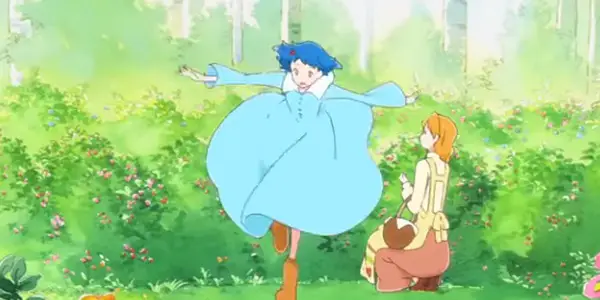LIZ AND THE BLUE BIRD: Intimacy In Style & Song

Ben is a former student of cognitive science who is…
Liz and the Blue Bird is the fourth feature film by Naoko Yamada. Each of her films has demonstrated more formal mastery than the last, and this is no exception. She makes animated characters come to life not just through their motion, but by letting us into their emotional worlds. We see what matters to them. We see the imperceptible, private elements of their reactions to the events around them. We see their intentions.
Her last film, 2017’s A Silent Voice, had a much denser and heavier story than her other films. It’s somewhat long, at 130 minutes, and it still feels like almost too much stuff happens in it. Thankfully, its stylistic measures make it possible to condense everything in a way that remains emotionally comprehensible.
A Silent Voice‘s formal qualities are interesting in their own right. Liz and the Blue Bird does something different: it has a much sparser story, and therefore faces less of a struggle to ensure the audience understands relevant information. Rather, it takes its time using similar techniques to explore the details and hidden emotional gravity of seemingly unremarkable situations.
The Bluebird’s Song
Liz and the Blue Bird is about the relationship between two girls, Mizore Yoroizuka and Nozomi Kasaki, with Mizore as the primary character. They both belong to the Kitauji High School Concert Band; Mizore plays oboe, and Nozomi plays the flute. The film is a spin-off of a TV series called Sound! Euphonium, but there’s actually no need to have seen the series to appreciate the film. The film is self-contained, perfectly capable of standing alone.
It’s a very private affair, containing only a few characters besides Mizore and Nozomi who really matter. This is their story. Mizore is extremely withdrawn: she often speaks in a whisper and doesn’t express much interest in socializing with anyone other than Nozomi. Nozomi is more sociable.

With the concert band, they’re practicing a piece of music called “Liz and the Blue Bird,” based on a fairy tale about a lonely woman named Liz who forms a relationship with a bluebird that took on human form. At the end of the story, Liz allows the bluebird to fly away and leave her. Nozomi says she thinks this is a sad ending, and would prefer one where the bird returned. Mizore doesn’t understand the ending at all: she can’t comprehend why Liz would let the bluebird go if she loved her.
The film alternates between depictions of the girls at school and depictions of the fairy tale. The point is obvious: the love between Liz and the bluebird is meant to reflect the love between Mizore and Nozomi. Many of Mizore’s lines in the movie state this outright. The film does not make it difficult to understand the nature of the problems in Mizore and Nozomi’s relationship, though it ends up in a place one might not expect – but even then the characters’ dialogue explains exactly what the unexpected turn is.
Usually, we prefer films to show rather than tell, and Liz and the Blue Bird tells us a great deal. But this is hardly a problem for the movie. Knowing what the characters are dealing with complements what the movie shows us in a way that builds tension: we know what Mizore is thinking, but we don’t know how she’s going to manage to communicate it, or how it’s going to shape her reactions to the people around her. This tension is a huge part of what makes the film’s climax as moving as it is, and it’s made possible by how much the film lets us know about what’s going on inside the characters’ heads.
Inside the Birdcage
The film’s tension, to be specific, is a sense of longing and a fear of disappointment. These are Mizore’s feelings, and we experience them, quite literally, alongside her: the camera is often so close to Mizore that we can’t see her whole body. We see just her eyes as she impassively watches the other band members, or as she tries to read Nozomi’s body language. We see just her feet, or just her hands behind her back, as she fidgets uncomfortably when other characters ask her questions. We see her habit of playing with her hair. These moments are imperceptible to the other characters, but the viewer is allowed to see into the private realm of Mizore’s uncertainties about her own future and her relationship with Nozomi.

We sometimes see Nozomi this way too, from so close up that the frame cuts off most of her features. While we don’t spend as much time with her private feelings as we do with Mizore’s, Nozomi’s perspective proves extremely important to what the film is doing. In fact, it’s by allowing us to see directly through her eyes that the film pulls off one of its most effective scenes.
The film uses a distinctive soundtrack which doesn’t sound quite like that of any other film. The film’s composer, Kensuke Ushio, hoped it would convey the nature of Mizore and Nozomi’s interactions: namely, the unique role each plays in the other’s life and the way their differences affect their communication. The score often sounds as though it’s building up to something, though in a rather casual way, like a band preparing for practice. There’s diegetic music too: the song Mizore and Nozomi perform for the concert band is a pensive-sounding piece meant to represent the parting of Liz and the bluebird. In an impressive act of sound mixing, the final performance of this song stands out from all the others – it’s not until then that we fully understand its emotional content.
Exactly what the characters long for is illustrated in the fantasy sequences depicting Liz and the bluebird. The bluebird’s hair permanently looks swept up, as if by the wind. When her feet leave the ground or her clothing billows, it takes just a little longer than you expect for them to come back down. Her presence generates a sense of freedom and lightness that we don’t find in the scenes that take place in reality.
In the fantasy world, the camera gives the characters more room to breathe and we get to see open, outdoor spaces. The scenes that take place in reality rarely leave the school building. The fantasy features a variety of colors in flowers, fruits, animals, and clothing. Reality is a bit duller, colored mostly by the whites, grays, and beiges of the school’s interior and the colors of the students’ identical uniforms. The fantasy gives us a glimpse of relief from anxiety and the notion that something might lie beyond it; whether it’s real and whether we’ll ever get there is the film’s central conflict.

One thing alters the color scheme of the school: early evening sunlight pouring in through the windows gives everything a golden tint. It’s such a subtle, simple trick, but it makes all the difference. There are recognizable stylistic traits shared by all of Yamada‘s works. Liz and the Blue Bird uses those traits to create information and sensations for the audience to take in, rather than simply complement the story’s events.
Liz And The Blue Bird: New Performance
From a formalist perspective, all of Yamada‘s films are fascinating, and Liz and the Blue Bird might be the most fascinating for its contrasts of style and color, and for its elaborate soundscape. Moreover, the formalist might be impressed by how much these things bring to a film whose story has so little action.
And there’s plenty here for those who go to the movies for other reasons. The film generates sustained tension and intimacy, and its ending works off these things to an unforgettable effect. It’s not a film for those who are more interested in dramatic events or complicated stories than characters’ inner lives. For those who can invest themselves in form or Mizore’s struggle with communicating her feelings to Nozomi, it comes highly recommended.
Do you prefer Yamada taking time to glean hidden details from small events, or organizing a complex story? Tell us your thoughts in the comments below!
Liz and the Blue Bird was released in the US on July 6, 2018. For all international release dates, see here.
Does content like this matter to you?
Become a Member and support film journalism. Unlock access to all of Film Inquiry`s great articles. Join a community of like-minded readers who are passionate about cinema - get access to our private members Network, give back to independent filmmakers, and more.
Ben is a former student of cognitive science who is currently trying to improve his writing style and ability to understand and appreciate films containing unfamiliar perspectives. He tries not to hold films to a strict set of criteria, but does believe that strong movies can change your outlook on the world. His favorite films include Whisper of the Heart, Hellzapoppin', Foolish Wives, 42nd Street, and the work of Charlie Chaplin.













